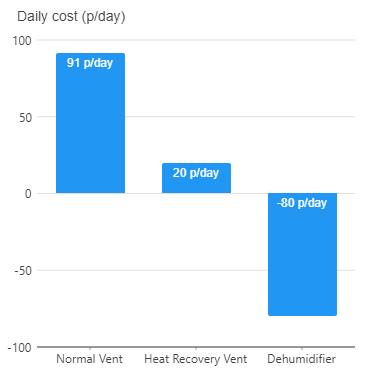The Surprising Benefit of Dehumidifying
Winter and Covid combined mean we’re spending a lot of time at home. That means generating moisture. Moisture brings higher humidity, condensation and eventually mold.
To understand the most energy efficient way of fixing this, I calculated the energy required for venting and dehumidifying. This revealed something surprising - running a dehumidifier can actually save money. The heat released by condensing the water in the air means it produces more heat than the electricity it uses.
As every home is different, I built an interactive calculator so you can see what’s best for you.
My Home
My flat is a 1950 building with brick cavity walls. At some point in the past, probably when cavity wall insulation was fitted, most of the air bricks in the flat were sealed up. This reduced airflow - reducing heat loss but also keeping moist air inside.
Right now the humidity is almost 75%, giving us problems with condensation on windows and some of the colder walls. Mold has started to grow on these damp surfaces.
It turns out mold thrives indoors at these humidities. Fortunately you don’t need to drop the humidity by much for it to no longer be a problem. The danger zone is above 70% humidity - by 65% humidity the mold risk is almost nothing.
Ways to deal with moisture
Humidity is caused by cooking, washing, drying clothes and breathing. We can’t do much about the last one.
We’ve effectively got 2 options.
- Ventilate more (open windows, fans etc)
- Extract moisture from the air with a dehumidifier
But which should I do?
Well, the best choice depends on your house - how many people live there, the climate you live in, and the cost of your electricity and heat.
Cost calculator
To answer the question, I put together an interactive calculator. Put in your circumstances and it will tell you the cost of each method. I’ve also included the use of a heat recovery extractor fan - this type of fan recovers around 80% of the heat in the outgoing air back into the fresh air. Wall mounted ones can be retrofitted in the place of normal bathroom fans.
For my 2 person household, when we’re home all day we generate around 6.5L a day. On a cold winters day in London, it’s 3 degrees with 88% humidity outside. To vent this moisture we’d need to change 37 m3 of air every hour.
Our heating comes from gas - which costs significantly less than electricity. For us, venting 37 m3 of air means an additional 19p/day in heating. If we installed a heat recovery vent that would go down to 4 p/day. A dehumdifier would cost 6 p/day to run (taking into account the heat it generates).
Dehumidifying saves energy
It turns out sometimes running a dehumidifier can actually save money.

If you use normal electric heating, an interesting thing happens. The cost of running a dehumidifier actually becomes negative - it releases more heat into the room than the electrical energy it consumes. This is because not only is all the power consumed by the dehumidifier released into the room, it releases additional heat (the heat of condensation) when water vapour condenses into water.
What to do
Doing this calculation has revealed a few things.
Firstly, the cost of energy isn’t very high. Even the most inefficient method only costs 20p a day - if humidity is a problem for 6 months of the year, venting is only going to cost me £36.00. That makes it very hard to justify the hundreds of pounds it would cost to install a basic heat recovery system.
It’s no surprise that, in the UK, our houses are mostly poorly insulated and sealed. It’s not worth the cost. I’ve written before about how energy is just too cheap to encourage green technology, and I think this emphasises this.
Secondly, I was surprised to learn that dehumidifying can pay for itself. It effectively has a Coefficient of Performance of more than 1. If you’re using electric heat and have a humidity problem, getting a dehumidifier is a no-brainer.
Calculations
The calculations use a number of steps:
- Estimate how much moisture is released into the air, based on these figures
- Calculate the amount of water in a m3 of indoor and outdoor air
- Then we can calculate the amount of air needed to be replaced with outdoor air in order to remove all our moisture
- To get the cost of venting, we use the specific heat capacity of air to calculate the amount of heat energy which is lost
- The cost of a heat recovery vent is based on recovering 78% of the heat.
- The cost of dehumidifying is based on a 20L/day 255W dehumidifier and scaled based on the volume of water generated each day.
Comments powered by Talkyard.